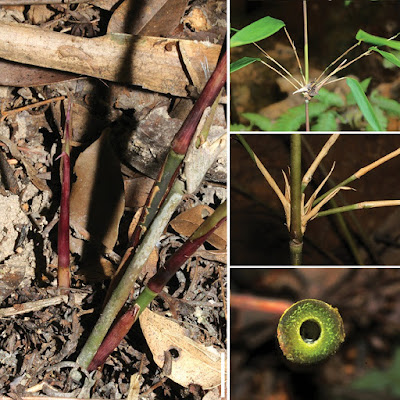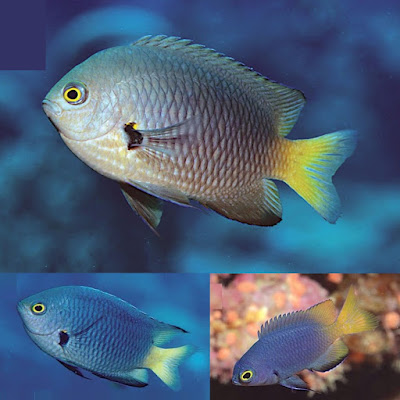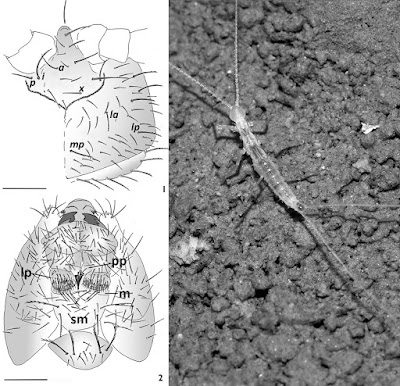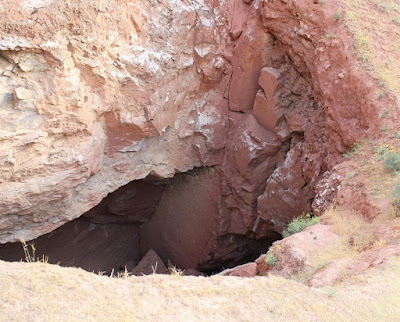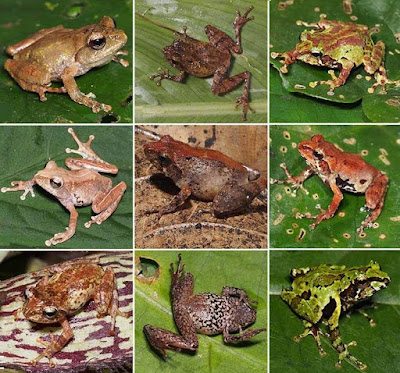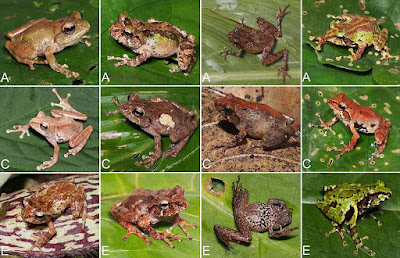[Most Recent Entries] [Calendar View]
Monday, September 25th, 2017
| Time | Event | ||||||||
| 1:00a | [Botany • 2017] Gelidocalamus xunwuensis • A New Species (Poaceae, Bambusoideae) from southeastern Jiangxi, China
Abstract Gelidocalamus xunwuensis W.G.Zhang & G.Y.Yang, a new species collected from Xunwu County of Jiangxi Province in China, is described and illustrated. The new species is similar to G. stellatus in the habit, but differs by internodes sparsely hairy with granuliferous warts, culm sheath stiffly hairy, culm sheath blade broadly lanceolate to narrowly triangular, each node with a ring of appressed trichomes below, foliage leaves broadly lanceolate to narrowly oblong, and new shoots occurring in late October. Keywords: Arundinarieae, Bambusoideae, bamboo, leaf epidermis, SEM, taxonomy Gelidocalamus xunwuensis W.G.Zhang & G.Y.Yang, sp. nov. Diagnosis: Similar to G. stellatus Wen (1982: 22) in the habit and branch, but differs by culms sparsely hairy (early period) with granuliferous warts (adult or later period), each node with a ring of fulvous appressed trichomes below, culm leaf sheath densely hispidulous with a blade broadly lanceolate and 3–5–paired oral setae, branch sheath glabrous, foliage leaves broadly lanceolate to narrowly oblong, and new shoots late October. Etymology: The species epithet xunwuensis refers to the locality of the type specimen: Xunwu County, Jiangxi, China. Distribution and habitat: Gelidocalamus xunwuensis occurs under evergreen broad-leaved forests, along ravine, and roadsides at elev. ca. 400–600 m. It grows together with Castanopsis kawakamii Hay., Dicranopteris pedata (Houtt.) Nakaike, Gnetum parvifolium (Warb.) C. Y. Cheng & Chun, Eurya chinensis R. Br., Semiliquidambar cathayensis H. T. Chang, and Ormosia semicastrata Hance. Gelidocalamus xunwuensis is currently known from only one small populations (less than 100 culms) in the southern China.  Wen-Gen Zhang, Xue-Nan Ji, Yu-Guang Liu, Wei-Jian Li and Guang-Yao Yang. 2017. Gelidocalamus xunwuensis (Poaceae, Bambusoideae), A New Species from southeastern Jiangxi, China. PhytoKeys. 85: 59-67. DOI: 10.3897/phytokeys.85.13804 | ||||||||
| 6:38a | [Ichthyology • 2017] Pomacentrus flavioculus • A New Species of Damselfish (Teleostei: Pomacentridae) from Fiji and Tonga
Abstract Pomacentrus flavioculus n. sp. is described on the basis of 140 specimens, 17.1–86.8 mm SL, from Fiji and Tonga in the South Pacific Ocean. The new species was formerly identified as Pomacentrus imitator (Whitley, 1964), which now appears to be restricted to the Coral Sea. The new species clearly differs from P. imitator on the basis of several color-pattern features, including a bright yellow ring that encircles the pupil, a more uniform body color (vs. contrasting pale scale centers and dark scale margins), a yellowish caudal fin (vs. whitish), and a small orange marking immediately above the large black spot that covers the pectoral-fin base (absent in P. imitator). Although meristic and morphological features are broadly similar, P. flavioculus has a strong mode of 14 anal-fin rays vs. 15 in P. imitator. Additionally, P. flavioculus usually has a greater preanal distance and almost always has a longer pelvic-fin spine. A phylogenetic analysis of concatenated mtDNA sequences shows the new species is 8.4% divergent (average pairwise distance) from its nearest relatives and is part of the broad Pomacentrus philippinus species complex.
Pomacentrus flavioculus, n. sp. Yelloweye Damselfish Etymology. The new species is named flavioculus (Latin: yellow eye) with reference to the diagnostic yellow ring that encircles the pupil. Distribution. The new species is known only from Fiji and Tonga (Fig. 3), where it is commonly encountered in depths of about 4–30 m. It occurs on both outer reefs and in lagoons, usually adjacent to steep coral formations with abundant ledges and overhangs. Gerald R. Allen, Mark V. Erdmann and P.D. Pertiwi. 2017. Pomacentrus flavioculus, A New Species of Damselfish from Fiji and Tonga (Teleostei: Pomacentridae). Journal of the Ocean Science Foundation. 28, 22–33. DOI: 10.5281/zenodo.896910 | ||||||||
| 7:07a | [Hexapoda • 2017] Turkmenocampa mirabilis • A Striking New Genus and Species of Troglobitic Campodeidae (Diplura) from Central Asia
Abstract A striking new genus and species of Campodeidae (Diplura), Turkmenocampa mirabilis Sendra & Stoev, gen.n., sp.n., found in Kaptarhana cave in Eastern Turkmenistan is described. This represents the first record of Diplura from Central Asia and also the first terrestrial troglobiont found in Turkmenistan. The new taxon shows several unique characters such as the lack of crests on the telotarsus, the presence of a side-shoot process and the shape of barbs on the ventral side of the laminar telotarsal processes hitherto unknown in other members of this family. Although T. mirabilis is tentatively placed in the subfamily Plusiocampinae, its true affinities remain uncertain. The new finding provides further support to the importance of Kaptarhana as a refuge for a number of endemic invertebrates. Keywords: Turkmenistan, Koytentag Mountain, Turkmenocampa mirabilis, identification key, Plusiocampinae, cave fauna
Turkmenocampa Sendra & Stoev, gen. n. Type species: Turkmenocampa mirabilis Sendra & Stoev, sp. n. Etymology: Turkmenocampa is a composite name comprising “Turkmeno”-referring to the type locality and the suffix ‘-campa’ traditionally used in Campodeidae taxonomy. Gender: feminine. Turkmenocampa mirabilis Sendra & Stoev, sp. n. Etymology: ‘mirabilis’ is a Latin adjective meaning “unusual, amazing, wonderful, remarkable”. The specific epithet refers to the unique micro-sensilla in the cupuliform organ which resemble sponges and micro-corals. Habitat: Although Turkmenocampa mirabilis has so far been found only in the larger gallery of the cave, some 200–250 m inside the cave, it might well be that it also inhabits the other main passage of the cave. The species is a troglobiont, all records deriving from the aphotic zone of the cave. No specimens were however observed during the exploration of the cave, those that were trapped being found in humid locations, rich in guano.
Alberto Sendra, Boris Sket and Pavel Stoev. 2017. A Striking New Genus and Species of Troglobitic Campodeidae (Diplura) from Central Asia. Subterranean Biology. 23; 47-68. DOI: 10.3897/subtbiol.23.14631 Strange troglodyte species found in Turkmenistan cave upi.com/6632360t ข้อมูลจาก @upi | ||||||||
| 9:16a | [Herpetology • 2017] A Taxonomic Revision of the Philautus (Anura: Rhacophoridae) of Sumatra with the Description of Four New Species; P. amabilis, P. polymorphus, P. thamyridion & P. ventrimaculatus
Abstract This paper is the first taxonomic treatment of Sumatran Philautus since the early 20th century. We redescribe P. cornutus and P. petersi from new specimens, restrict P. petersi to Great Natuna Island, and reinstate the name P. larutensis for the populations on Borneo, Peninsular Malaysia, and Sumatra. We then synonymize P. similis with P. larutensis. We report Sumatran populations of P. kerangae and P. refugii, two species previously thought to be endemic to Borneo and discuss the presence of P. aurifasciatus on the island. We describe four new species of Philautus collected during large-scale herpetological surveys of Sumatra between 2013 and 2015 and propose a hypothesis of their relationship to the other Sunda Shelf Philautus on the basis of 16S ribosomal ribonucleic acid sequences. Additionally, we provide a key to the Philautus of Sumatra. In the course of this work we transfer P. vittiger from Java to the genus Chiromantis. Keywords: Anuran taxonomy, Biodiversity, Biogeography, Sunda Shelf
Previously Described Species • Philautus cornutus (Boulenger 1920) • Philautus kerangae Dring 1987 • Philautus larutensis (Boulenger 1900) • Philautus petersi (Boulenger 1900) • Philautus refugii Inger and Stuebing 1996 New Species • Philautus amabilis sp. nov. Etymology.—The name amabilis is a masculine adjective from Latin meaning lovely. It is an apt description of this charming species. • Philautus polymorphus sp. nov. Etymology.—The name polymorphus is a masculine adjective derived from the Greek words poly, meaning many, and morph, meaning shape or form. The name refers to the high levels of phenotypic variation displayed in this species. • Philautus thamyridion sp. nov. Etymology.—The new name, thamyridion, is a masculine noun in apposition and is a diminutive of the proper name Thamyris, a boastful singer of Greek mythology. The name refers to this species’ small size and loud distinctive call. • Philautus ventrimaculatus sp. nov. Etymology.—The specific name ventrimaculatus is a masculine adjective derived from the latin words venter, referring the stomach, and macula, meaning spot. The name is in reference to the distinctive pattern on the venter of this species. Elijah Wost, Awal Riyanto, Amir Hamidy, Nia Kurniawan, Eric N. Smith and Michael B. Harvey. 2017. A Taxonomic Revision of the Philautus (Anura: Rhacophoridae) of Sumatra with the Description of Four New Species. Herpetological Monographs. 31(1); 70-113. DOI: 10.1655/HERPMONOGRAPHS-D-16-00007 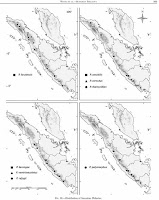 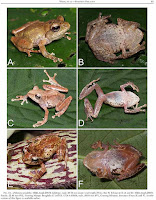 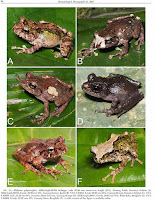 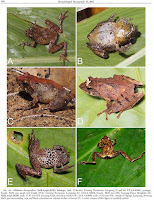 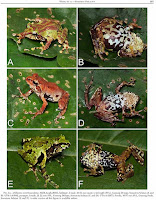 Specimens of the newly described species — Philautus amabilis, Philautus polymorphus, Philautus thamyridion and Philautus ventrimaculatus — were collected from 2013 to 2015 in jungles over 1,000 meters above sea level. Four new toads discovered in Sumatra news.mongabay.com/2017/09/four-new-toads-d Empat Spesies Katak Baru dari Genus Philautus Ditemukan di Sumatra nationalgeographic.co.id/berita/2017/08/e |
| << Previous Day |
2017/09/25 [Calendar] |
Next Day >> |
